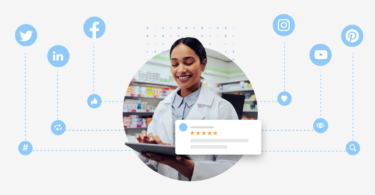Social media analytics is the backbone of every successful social media strategy. It shows you what content resonates, when your audience is most active, and how your efforts impact business outcomes. Without it, you’re guessing instead of growing.
Whether you’re managing one profile or dozens, effective social media analytics tools make tracking performance easier.
These tools help you turn numbers into actionable insights, from audience behavior to engagement trends, so you can refine your social media marketing strategy with confidence.
In this blog, we’ll explain what social media analytics refers to, why it matters, and how to use it to improve your campaigns.
You’ll also learn how to read social media analytics reports, uncover smarter ways of analyzing social media data, and drive better results across every platform you use.
Table of contents
- What is social media analytics?
- Six types of social media analytics to track in 2026
- What is the importance of social media analytics?
- How to get started with social media analytics tools (and use them effectively)
- Emerging trends in social media analytics (2026 and beyond)
- Social media analytics: Turn data into action with smart recommendations
- Frequently asked questions about social media analytics
- Compare social media results and drive smarter strategy with Birdeye
What is social media analytics?
Social media analytics is the process of collecting and analyzing data from social media platforms like Facebook, LinkedIn, and Instagram to understand how your audience interacts with your brand. This data includes metrics like likes, shares, comments, reach, and follower demographics.
By understanding your audience, you can create campaigns that resonate with them, leading to more engagement, conversions, sales, and business results.
Six types of social media analytics to track in 2026
Every social media marketer should track these essential types of social media analytics to improve campaigns and customer experience. Each delivers unique data points that help sharpen strategy and drive smarter decisions.
1. Social listening analytics
Social listening analytics tracks real-time conversations about your brand, products, competitors, or industry across social platforms. It’s a powerful way to discover what your audience is talking about and what they care about.
Use it to:
- Monitor brand mentions
- Identify emerging trends or PR risks
- Understand customer pain points
For multi-location brands, social listening offers vital feedback to support localized messaging and better customer engagement.
2. Sentiment analysis
While social listening tells you what people are saying, sentiment analysis reveals how they feel. It identifies whether the tone of those conversations is positive, negative, or neutral.
Use it to:
- Track reputation trends
- React quickly to shifts in public opinion
- Tailor messaging during product launches or crises
Pro tip: Use Birdeye Insights AI to track your Sentiment Score, an GenAI view of how customers feel based on reviews and surveys. Spot emerging trends, relevant data, improve experiences and grow faster across all locations.
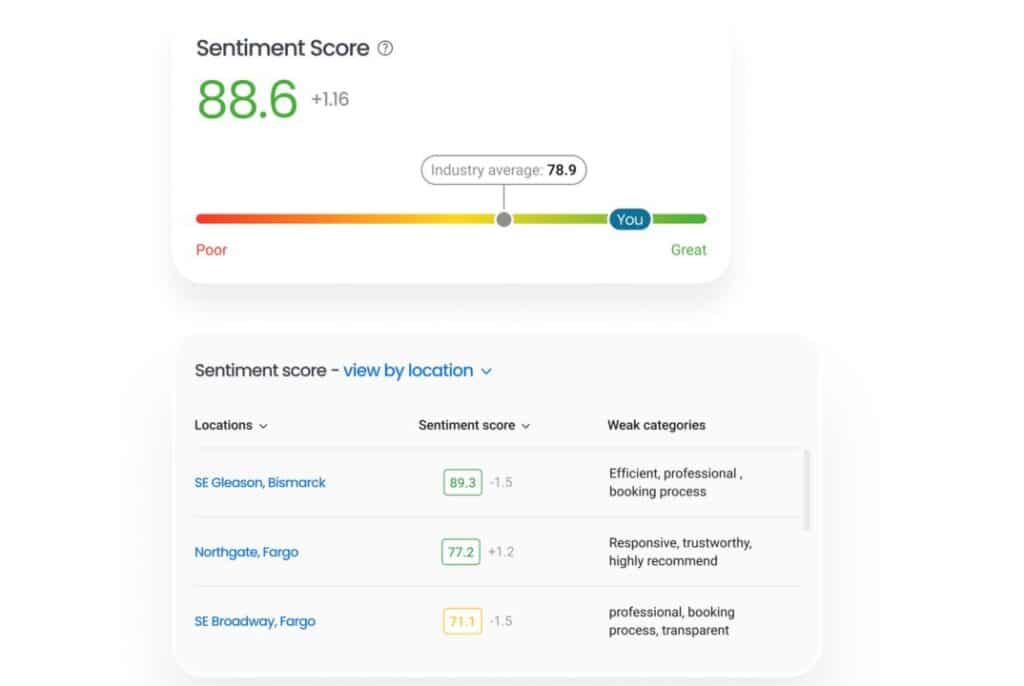
3. Influencer analysis
Influencer analysis identifies individuals who hold sway over your target audience. By understanding who shapes opinions around your brand or niche, you can build partnerships that drive engagement, grow web traffic, and expand brand reach.
Use it to:
- Discover potential brand ambassadors
- Track who’s driving buzz around your brand (or competitors)
- Strengthen influencer marketing and competitive edge
4. Performance analysis
Performance analytics give you a pulse on how your social content is performing. These metrics show which posts, campaigns, and channels are working —and which ones need improvement.
Key metrics include:
- Impressions, reach, likes, shares, comments
- Video views and link clicks
- Sales or conversions from social posts
5. Audience analytics
This type of analytics helps you understand who your audience is and whether you’re reaching the right people.
Key audience data includes:
- Age
- Gender
- Location
- Device usage
6. Competitor analytics
Competitor analytics helps you monitor how other brands in your space are performing on social media and where you stand in comparison. It gives you insight into their strategies, engagement levels, audience response, and growth trends.
Key competitor data includes:
- Follower growth and engagement rate
- Posting frequency and content formats
- Top-performing posts or campaigns
- Share of voice and sentiment comparison
Together, these types of analytics form a powerful foundation for conducting regular social media audits. When used correctly, they empower marketers to adapt campaigns in real time, strengthen customer relationships, and boost the long-term ROI of their social media management efforts.
What is the importance of social media analytics?
Making marketing decisions without data analysis is like setting sail without a compass. You’re investing time, money, and effort without knowing what’s working.
With the right insights from social media analytics, you’re no longer guessing. You’re analyzing data, spotting emerging trends, and aligning every move with your business goals.
Here’s why investing in social media analytics is essential to any smart digital marketing strategy:
1. Deeper audience understanding
With accurate audience analytics, you can learn who engages with your content, what they care about, and how they behave across platforms. This helps you reach the right people with messaging that actually resonates, turning impressions into action.
2. Data-driven content creation
Analyzing data around content performance reveals what your audience wants to read, watch, and share. This allows you to shape your strategy around proven formats, boosting engagement and improving the odds of conversions.
3. Competitive advantage
Social media is a competitive arena. With analytics, you gain visibility into what your competitors are posting, how audiences respond, and what tactics they’re using. This form of data analysis supports smart competitive benchmarking, helping you adapt and outperform.
Pro tip: With Birdeye Competitors AI, uncover valuable insights through cross-platform reporting to benchmark and analyze competing businesses. Use the data to drive smarter strategies and fuel data-driven decision-making that gives you a competitive edge.
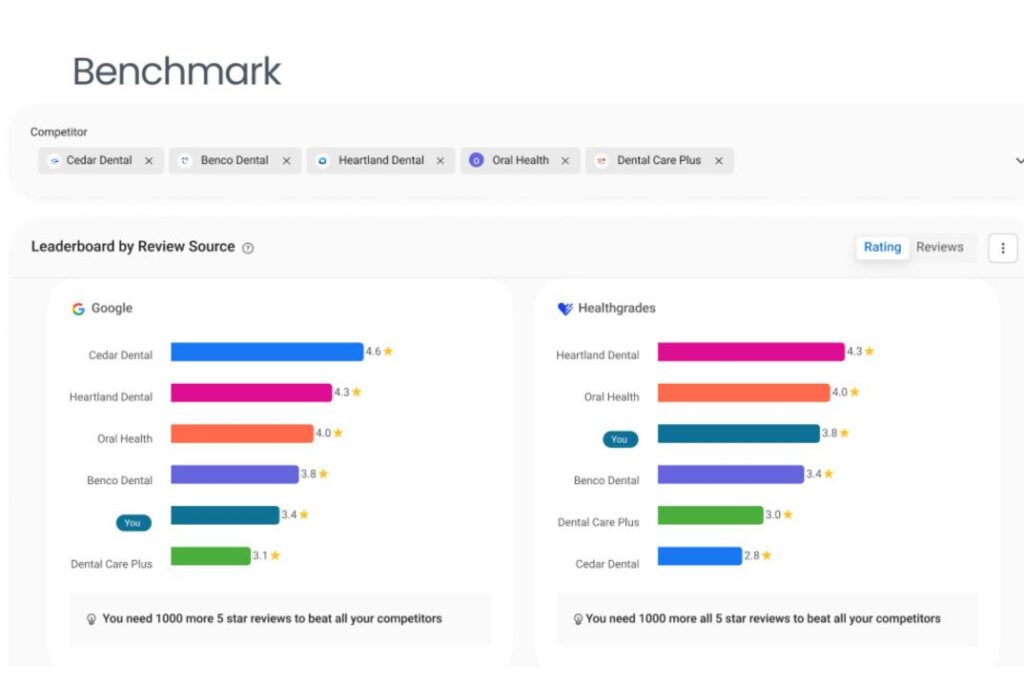
4. Clearer ROI measurement
Every campaign should have a measurable impact. With the right tools, you can tie key performance indicators like engagement, clicks, and conversions back to specific efforts. These tools also help you create custom reports to clearly showcase the ROI of your digital marketing initiatives.
5. Continuous optimization
Analytics gives you a long-term view of your strategy. By tracking what’s working and what isn’t, you can refine your strategy, reallocate budget, and build a more scalable, sustainable marketing program.
6. Stronger brand perception insights & security
Beyond structured metrics, modern platforms can also analyze unstructured data like comments and reviews, giving you deeper insights into brand perception. And with growing concerns around data security, today’s tools ensure your social media analytics efforts are both effective and compliant.
[Free Guide] The ultimate social media marketing guide for businesses
Download Now
How to get started with social media analytics tools (and use them effectively)
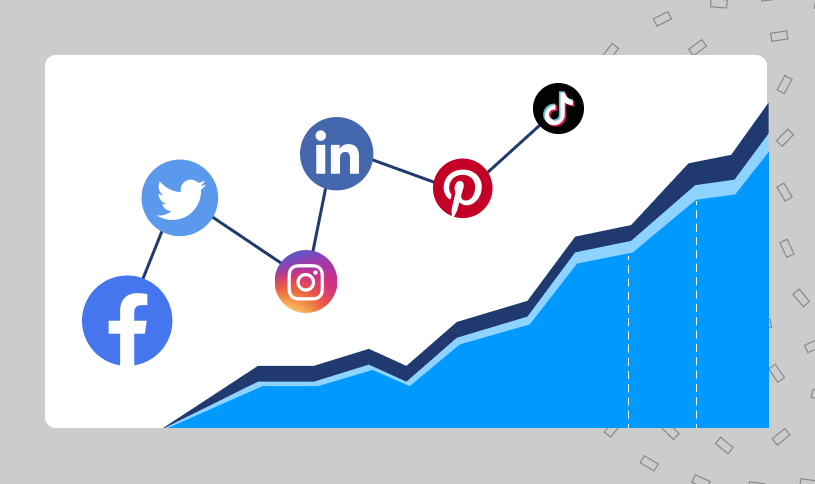
To start reaping the benefits of social media analytics, consider following these simple tips:
1. Set your goals
Before you start tracking your social media data, you’ll need to decide what your goals are. For example, are you interested in increasing brand awareness, or are you using your social channels to generate leads and drive sales? Understanding what you’re trying to achieve will help you identify the metrics that are most important for tracking your success.
2. Choose the right social media analytics platform
Most social media platforms provide analytics features that make it easy to understand how your content is performing. However, some third-party software can offer more in-depth insights and can better track performance. This is especially important if you are using more than one social media channel or if you’re a multi-location business. Choose a platform that fits your business size, channels, and reporting needs.
Analytics that fuel strategy.
Want to see the impact of Birdeye on your business? Watch the Free Demo Now.
3. Track relevant metrics
After selecting a platform, it’s time to start collecting data. Track the KPIs that actually reflect your objectives:
- Brand awareness → Impressions, reach
- Engagement → Likes, comments, shares
- Traffic → Click-through rate (CTR), referral traffic
- Conversions → Form submissions, purchases, cost-per-action
Also track audience analytics (age, location, device) to ensure you’re reaching the right people.
4. Monitor performance consistently
Analytics are most valuable when reviewed regularly. Weekly or bi-weekly reviews help you:
- Identify top-performing content
- Spot dips or spikes in engagement
- Catch campaign issues early
Set up dashboards and templates to track performance over time, compare periods, and detect long-term patterns.
5. Visualize your insights
Charts, graphs, and dashboards make your findings easy to understand, especially when sharing results with stakeholders. Visual data storytelling helps align teams and justifies strategic decisions.
Birdeye Social AI helps you post at the right time with smart social media analysis.
Get AI-powered tips based on your goal, like more reach or better engagement. See what’s working with clear social media data analytics, track social media performance, and reach your target audience when they’re most active.
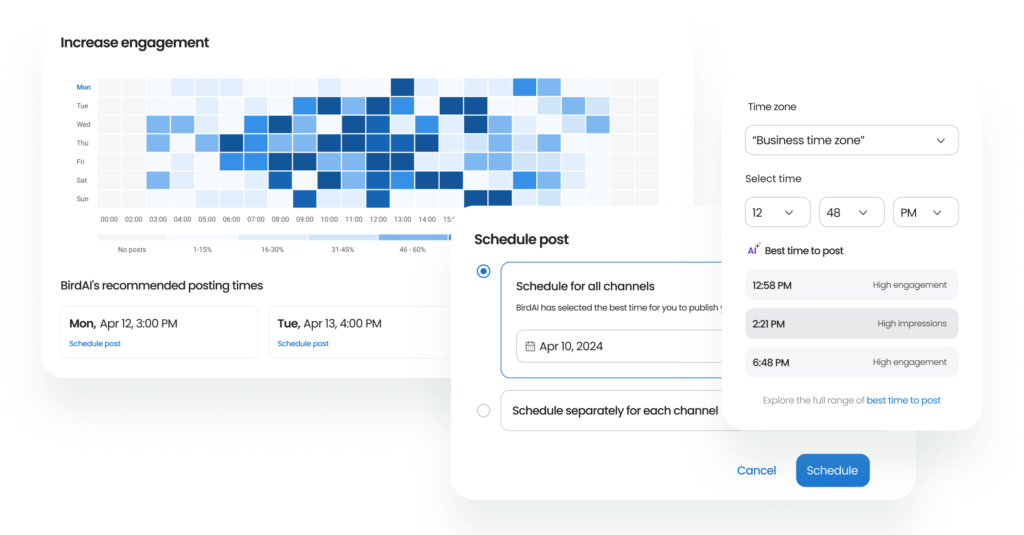
6. Create a data-driven culture
Employees must be data-driven in their thinking, from big projects to small tasks. This mindset won’t just set the tone for success – it’ll also create an understanding of how vital analytics are to a company’s culture.
Emerging trends in social media analytics (2026 and beyond)
Social media analytics is rapidly evolving beyond simple metrics and manual reports. With the rise of AI, privacy concerns, and content complexity, brands need smarter tools and faster insights to stay competitive.
Here are the top emerging trends shaping the future of social media analytics:
1. AI-powered predictive analytics
AI tools now forecast which content is likely to perform well, when your audience is most engaged, and how a campaign might impact future behavior.
2. Unified cross-platform analytics
Emerging tools have unified dashboards that now integrate multi-platform (Instagram, TikTok, LinkedIn, YouTube) performance into a single, cohesive view.
3. Real-time sentiment and emotion tracking
Emotion AI can detect nuances like sarcasm, frustration, excitement, or confusion even across emojis, slang, and visual content.
4. Privacy-first tracking and cookieless data
With growing regulations (like GDPR, CCPA) and platform restrictions, analytics tools are shifting toward privacy-safe methods.
5. Automated reporting and AI-generated summaries
Platforms now offer AI-generated reports that highlight key takeaways, trends, and recommendations, saving time and improving clarity.
These emerging trends signal a shift toward smarter, faster, and more intuitive social media analytics.
Social media analytics: Turn data into action with smart recommendations
After collecting and analyzing your data through social media analytics tools, the next step is turning those findings into strategic recommendations.
This is where the real impact of social media analytics comes to life. By reviewing social media analytics reports, you can identify patterns and performance gaps that inform smarter marketing efforts moving forward.
For instance, if a specific content format consistently drives higher engagement, you can recommend producing more of that content to maximize results.
If a recent campaign fell short, your analysis can reveal why, perhaps the timing, message, or channel was off, and offer actionable changes for the next round.
With advanced natural language processing features now embedded in many analytics platforms, even large volumes of feedback and comments can be turned into meaningful insights.
This process of data transformation turns raw metrics into clear, strategic guidance. It’s a key reason why social media analytics is important for shaping the future of your brand’s marketing efforts with clarity and confidence.
To help you organize and present your data findings, download our free social media reporting template.
And before you click away, read the ultimate guide to social media management.
Frequently asked questions about social media analytics
Social media analytics is the process of examining data from social media platforms to understand how people are engaging with that content. Social media analytics can be used to improve social media marketing campaigns, understand customer sentiment, and track brand mentions.
There are a number of social media analytics tools available to help you track and measure your social media metrics. A commonly used tool is social media monitoring software. This allows users to track social conversations in real time and engage with their followers in a more efficient way.
Yes, Google Analytics integrates with a variety of social networks, including LinkedIn, Twitter, and Facebook. It has the capability to track acquisition, behavior, and conversion data. However, it does not offer the same level of detail or in-depth analysis that you can get from specialized social media analytics tools.
Yes, social media analytics tools can help you forecast what type of content or campaigns are likely to succeed by analyzing past performance trends, engagement patterns, and audience demographics. While not foolproof, predictive analytics powered by natural language processing and AI can offer data-backed guidance to improve planning and reduce risk.
To track analytics across multiple clients or business locations, you’ll need tools that support cross-platform reporting and segmented views. Look for platforms like Birdeye Social AI that let you tag, filter, and compare performance by location, region, or brand. This helps you evaluate which marketing efforts are driving the most impact and tailor strategies accordingly.
Compare social media results and drive smarter strategy with Birdeye
Performance tracking across social media channels is now smarter, faster, and data-powered. With Birdeye Social AI, you get access to powerful social media analytics tools that reveal which content works, where your audience is most engaged, and how your brand is performing location by location.
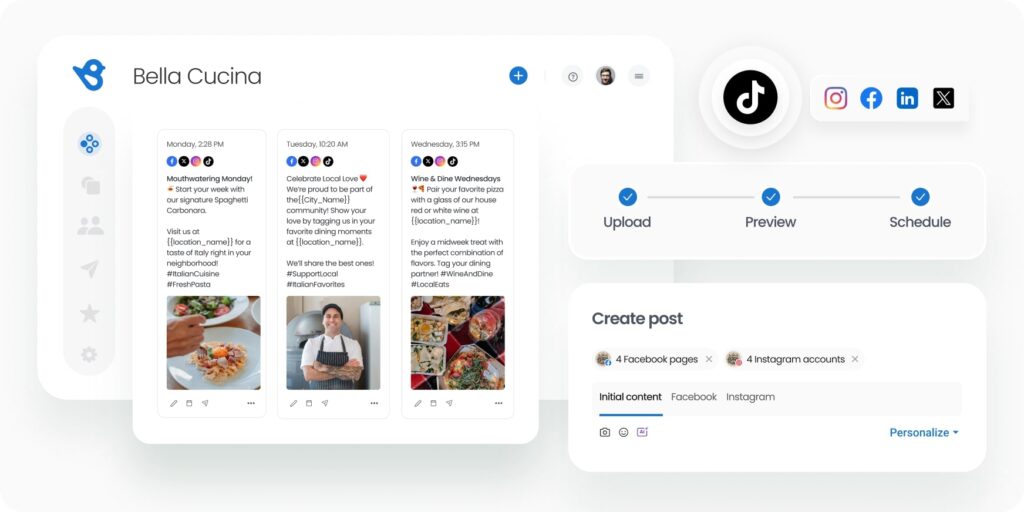
From reach and impressions to clicks, comments, and audience engagement, Birdeye tracks the key metrics that matter most.
Whether you’re managing one profile or hundreds, you can easily create reports that break down top-performing posts, monitor growth trends, and deliver data-driven insights for every region, particular campaign, or channel.
What sets Birdeye apart is how it turns social media analysis into action. You can instantly generate content with AI tailored to your business and audience.
Our platform helps you craft high-performing posts, pull in user-generated content, and visualize your performance with clean, easy-to-understand reports. This is a digital transformation for social media marketers backed by real-time data, AI, and a centralized dashboard.
The data gathered from your efforts fuels meaningful insights that refine your social media strategy and boost ROI. And with built-in cross-location reporting, you’ll always know what’s working and where to optimize.
Watch a free demo today to explore Birdeye.

This blog post is part of our Social Media Management Guide
Originally published



